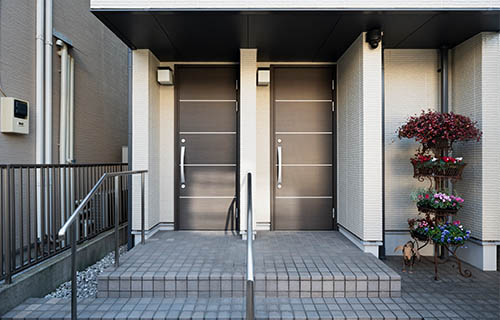Doors Design
Doors Design

Design of doors made of wood or aluminum
Designing doors using materials such as wood or aluminum depends on the specific uses, whether for interior or exterior doors, as well as preferences in terms of appearance, durability, and insulation. Both types have unique features, and I will provide you with a comparison between them to clarify the most important characteristics of each type.
1. Wooden Doors:
Features:
- Classic and warm appearance: Wood offers a natural and attractive look that suits classic and rustic designs. It also gives a sense of warmth and luxury.
- Durability: Wooden doors made from solid wood like oak or beech are durable and can withstand heavy use.
- Customizable: Wooden doors can be easily customized in terms of carvings, colors, and architectural details, allowing for unique designs.
- Good insulation: Wooden doors provide good thermal and sound insulation, making them suitable for homes in cold climates or spaces requiring privacy.
Disadvantages:
- Maintenance required: Wood requires regular maintenance, such as polishing or repainting, to protect it from wear or moisture.
- Vulnerable to moisture and wear: If not properly treated, wood may be affected by moisture, causing warping or cracking.
- Higher cost: Solid wood doors can be more expensive compared to aluminum or treated wood doors.
Types of Wood Used in Doors:
- Solid wood: Like oak, beech, and mahogany, which are the best choices if you seek durability and luxury.
- Plywood (laminated wood): A more economical option, typically used for simple interior door designs.
2. Aluminum Doors (Alumetal):
Features:
- Modern and sleek look: Aluminum offers modern, elegant designs, making it a preferred choice in contemporary and minimalistic architecture.
- Weather-resistant: Aluminum is resistant to moisture, heat, and rain, making it ideal for exterior use in homes and businesses.
- Low maintenance: Unlike wooden doors, aluminum doors require minimal upkeep. They do not rust and maintain their appearance over long periods.
- Corrosion-resistant: Aluminum resists corrosion and oxidation, especially when treated with techniques such as electrostatic coating.
- Multiple design and color options: Aluminum is available in a wide range of colors and finishes, providing great flexibility in design.
Disadvantages:
- Less thermal and sound insulation: Aluminum does not insulate heat or sound as effectively as wood, unless manufactured with special techniques to enhance insulation.
- Cooler appearance: Aluminum may feel cold compared to the natural warmth of wood, which some may not prefer in interior environments.
- Less flexibility in carvings: Aluminum does not offer the same level of intricate detail or carvings that can be achieved with wood.
Types of Aluminum Doors:
- Sliding doors: Ideal for spaces needing large openings or access to gardens or balconies.
- Folding doors: Used in areas requiring full openings, commonly seen in commercial and modern architectural designs.
- Traditional doors: Hinged doors with sleek designs, suitable for residential or business entrances.
Comparison Between Wood and Aluminum:
| Element | Wooden Doors | Aluminum Doors |
|---|---|---|
| Appearance | Classic and warm | Modern and sleek |
| Durability | Durable but requires maintenance | Durable and weather-resistant |
| Thermal and sound insulation | Very good | Less effective in insulation |
| Cost | Generally more expensive | Usually less expensive |
| Maintenance | Requires regular upkeep | Low maintenance |
| Design flexibility | High flexibility in carvings and details | Flexible in colors but limited in carvings |
Choosing the Right Option for You:
- If you seek a classic, warm look with good insulation and prefer natural texture: Wooden doors are the ideal choice.
- If you prefer a modern design with high durability and low maintenance, especially for exterior use: Aluminum doors would be the best option.
